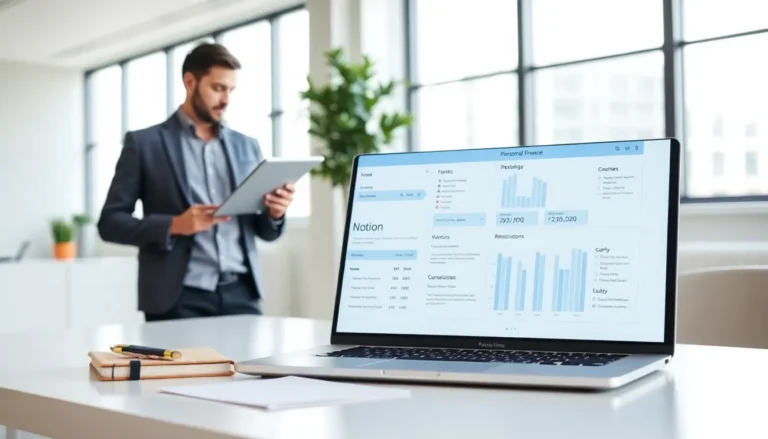Table of Contents
ToggleEver found yourself staring at a Google Docs link on your phone, wishing you could just open it in the app instead of wrestling with your browser? You’re not alone. Many people face this digital dilemma, but fear not! There’s a simple way to make your life easier and your documents more accessible.
Understanding Google Docs Links
Google Docs links direct users to specific documents stored in the cloud. Opening these links efficiently enhances productivity and simplifies document management.
What Are Google Docs Links?
Google Docs links serve as web addresses pointing to individual documents. Users receive shared links via email or messaging platforms. Clicking these links opens the document in a web browser unless configured to open in the app. Recognizing these links helps users navigate their documents swiftly.
Importance of Opening Links in the App
Opening links in the app streamlines access to documents. Apps provide a more user-friendly interface compared to web browsers. Features such as offline access, editing options, and notifications enhance user experience. App-specific functionalities allow for smoother collaboration and quicker interactions with documents. Setting default preferences for the app reduces time spent switching between platforms.
Methods to Open Google Docs Link in App
Opening Google Docs links directly in the app is possible through various methods, enhancing accessibility across different devices. These methods differ slightly based on whether users operate on mobile or desktop platforms.
Using Mobile Devices
Mobile users can easily open Google Docs links in the app by following these steps. First, tap on the link provided in a message or email. If the app is installed, it prompts users to select the app as the default option. Users can also long-press the link to see more options, selecting “Open with” and then choosing Google Docs. Setting Google Docs as the default app for these actions ensures a seamless experience moving forward. Notifications from the app can enhance user engagement, offering updates for any changes made to shared documents.
Using Desktop Devices
Desktop users have straightforward options for opening Google Docs links in the app. When using a web browser, clicking the Google Docs link may not automatically launch the app. Instead, users should copy the link from the browser and paste it into the app if installed. This step guarantees direct access to the document. Enabling app features in the browser settings or linking the app with Google accounts may also improve accessibility. Each method aims to streamline the process, making document management more efficient while boosting collaboration capabilities.
Troubleshooting Common Issues
Users may encounter specific challenges when attempting to open Google Docs links in the app. Addressing these common issues can help improve the overall experience.
Link Not Opening in App
A frequent issue involves links not opening directly in the Google Docs app. Users should check if the app is installed on their devices. If the app is absent, they need to download it from the relevant app store. Users might also verify whether the app has the necessary permissions to open links. Adjusting default app settings in the device’s configuration can resolve the problem as well. In addition, users can try copying the link and pasting it directly into the app to bypass this issue.
App-Related Problems
Occasionally, the app may not function as expected. Users should first confirm the app is updated to the latest version. Outdated versions can lead to compatibility issues. Additionally, clearing the app cache sometimes resolves performance problems. Users might also restart the app or the device itself to refresh the connection. If issues persist, reinstalling the app can often resolve persistent bugs or glitches.
Tips for a Smooth Experience
Users can enhance their experience when opening Google Docs links by following a few essential tips. Addressing update and permission management ensures seamless access to documents.
Ensuring App Is Updated
Keeping the Google Docs app updated is essential for optimal functionality. Regular updates include bug fixes and new features that enhance user experience. To check for updates on Android, users can visit the Google Play Store and tap on “My apps & games.” For iOS devices, the App Store provides a similar option under updates. If an update is available, downloading it ensures all features work correctly. It’s important to enable automatic updates for future convenience. Regularly updating the app reduces compatibility issues and enhances performance, ultimately leading to a more efficient document management experience.
Managing Permissions
Managing app permissions is crucial for opening links directly in Google Docs. Users should ensure the app has the necessary access to open files seamlessly. On Android, navigating to Settings and selecting Apps allows them to find Google Docs, where they can check permissions. For iOS, users can visit Settings, scroll down to Google Docs, and adjust the necessary permissions. Granting storage and network access enables smooth file interactions. If the app lacks these permissions, users might face difficulties accessing documents directly. Appropriately managing permissions not only ensures smooth functionality but also contributes to a more productive collaboration environment.
Opening Google Docs links directly in the app can significantly enhance the user experience. By following the outlined methods users can save time and enjoy a more streamlined approach to document management. Whether on mobile or desktop platforms the steps provided ensure easy access to essential features that improve collaboration and productivity.
Addressing common troubleshooting issues further empowers users to resolve any obstacles they may face. Keeping the app updated and managing permissions are key to maintaining a seamless experience. With these strategies in place users can confidently navigate their Google Docs links and make the most of their document management needs.








